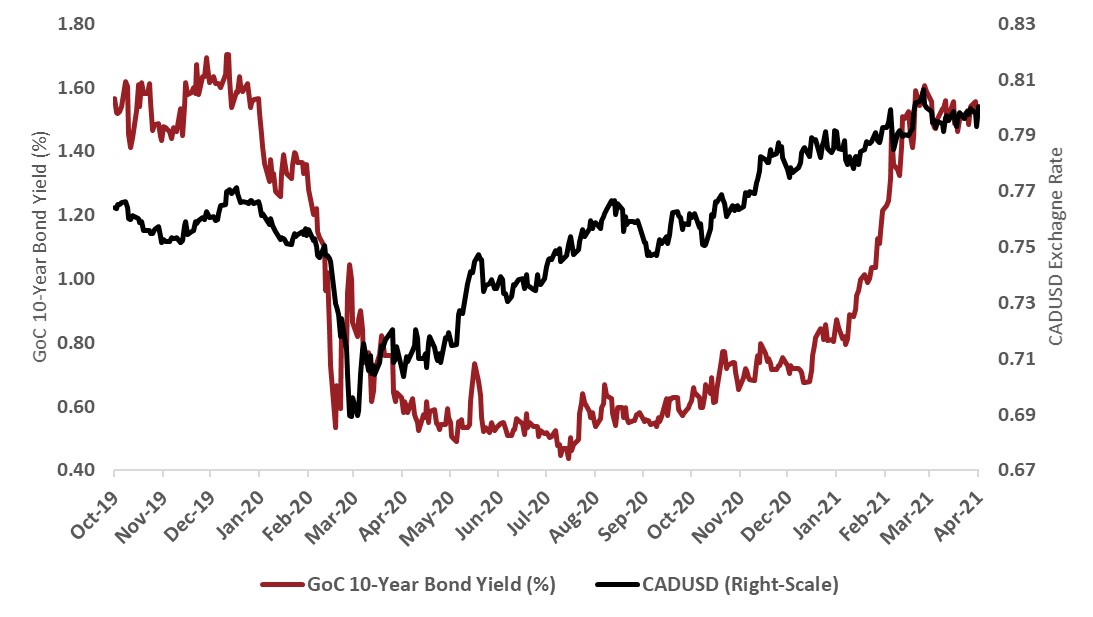Bank of Canada Update: Progress means moderation
Despite rising COVID cases, slow vaccine rollout, and localized lockdowns, the Bank of Canada (BoC) struck an optimistic tone at its April monetary policy meeting. The BoC unsurprisingly left its policy rate at 0.25%; however, it signaled a potential commencement to rate hikes as early as 2022.
At the press conference after the policy meeting, BoC Governor Tiff Macklem summarized the Governing Council's assessment of the economy and outlook with three words: progress, time, and commitment. Succinctly, economic progress has been more robust than initially expected; still, a full recovery will take time, and therefore, the BoC is committed to providing the necessary support. The implications of this assessment, however, are more nuanced. The BoC has materially upgraded its gross domestic product (GDP) growth estimate for 2021 to 6.5%. This is above consensus estimates of roughly 6% and a meaningful increase to their previous estimate of 4%. The consequence of this upgrade was twofold. The BoC announced a reduction of its bond purchase program to C$3 billion from C$4 billion per week, though indicating that its balance sheet is still expanding and stimulative for the economy even at this lower level. The Governing Council also believes economic slack will be absorbed, and the inflation objectives achieved by the second half of 2022, compared to 2023 previously. This indicates that federal interest rate hikes could potentially commence as soon as late 2022.
If so, the BoC would be setting itself apart from its G71 counterparts, the most important being the U.S. Federal Reserve (Fed). The Fed has not committed to tapering, or slowly reducing its bond-purchase program, and signaled it’s very unlikely to hike rates before 2023. We believe some recalibration is likely, with the BoC ultimately leaning towards the Fed's timing for "lift–off". This leads us to conclude 2023 would be the earliest the BoC would consider hiking interest rates.
The immediate market reaction to the policy announcement was a boost to the Canadian dollar (CAD) and higher bond yields. A brief update on both:
- CAD: We believe the loonie has the wind at its back. The Canadian economy has performed better than expected, commodity prices have rallied, the global economy is recovering, and the BoC has signaled it could hike rates before its G7 counterparts. These trends keep us positive on the outlook for the CAD, with the CAD expected to trade at levels above $0.80 to the U.S. dollar.
- Government of Canada (GoC) 10–yr bond yield: Bond yields have already risen by more than 100 basis points (bps) from the COVID–related lows. We believe this reflects much of the improved growth and inflation outlook. Movement in rates from here will be measured: our expectations for the GoC 10–year yield is to trade in a range of 1.5% to 2.0%.
The bottom line is that the central bank's assessment for the economy has improved and now more closely reflects the consensus outlook on growth, including ours. What remains to be seen is if the BoC commences a rate hiking cycle significantly ahead of the Fed. Ultimately, we believe the BoC will be patient, more closely aligning its hiking cycle with the Fed.
Click to enlarge image
Figure 1: Bond Yield & Exchange Rate
Source: Refinitiv DataStream, Russell Investments, as of 4/21/2021.
1G7 members are Canada, France, Germany, Italy, Japan, the United Kingdom and the United States.
